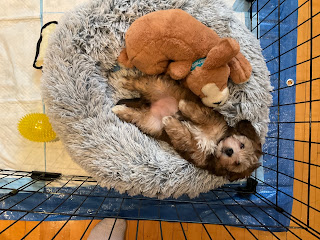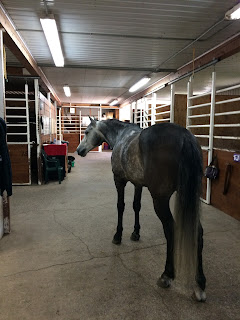Back to Basics, a lesson in walking
Regular lessons have not been in my wheelhouse lately. I've been mostly sporadic, opportunistic ... and much more focused on the trail riding then on practicing in the arena. Sometimes I might convert a trail ride into a training ride. But for the most part it's been about mileage, relaxation, and exposure. My Q is just fine with that. Especially if it comes with peppermints.
But I was asked to join a dressage clinic at the barn this week with a lovely French Classical trainer, who specializes in lusitanos. I thought it could be interesting to spend an hour talking about our shortcomings with someone familiar with the breed type (although my Q is an andalusian, but it is close enough) and get some tips and tricks on improving our contact, connection, and slowing down the canter.
I looked into her profile online, watched some videos, and hemmed and hawed. I wasn't sure I was ready to receive instruction from someone who did not quite share my philosophies on dressage. There was no way that I was going to embrace a strong dressage contact, and I wasn't sure what I could get out of one hour with someone I don't know and who I might potentially not share the same philosophy of lightness in training.
I talked to my husband, and he said : "Do you really want to spend $150 with someone for one hour of her telling you how you screwed up your horse? You are doing great with your horse. Why do you want to mess with that?"
Things that make you go hmmm.
So I decided to abort my plan of a dressage clinic, but I met her just the same when she came to the barn. Nice lady, and she was quite appreciative of my horse. I told her what my challenges were, what I wanted to work on, where the holes in my training were, what I had done in the past and what my objectives were. And then we both realized at the same time that she was not the right trainer for me. She has one way of doing things. And it's not my way.
No harm, no foul. And some serious dough and anguish saved.
But I got the bug in my ear, and I called my long-time coach for a last-minute lesson today. We haven't had a lesson in 18 months, so I started by showing him where I was at and what I wanted to work on. We connected immediately because we have hundreds of hours of working together with different horses. I showed him my leg yields (tight), my haunches in (sloppy), my halt (solid), my trot (loose and relaxed) and my canter (way too fast).
He then had me drop the reins and walk. Slower. Don't brace your back. Slower. One step at a time. Follow me. Slower. Like you are walking on your tippy-toes. And so we progressed through the various paces of walk (what we call 1 = baby steps, 2 = slow forward motion, 3 = slow and relaxed, 4 = natural pace, 5 = march) up and down, much like learning scales on a piano. Transitions within the walk.
Within fifteen minutes, Q was giving me the best connection I have ever had. No head tossing, bit sucking, mouth gaping, and tense neck. All this with the lightest contact and sometimes with drooping reins. In between gaits, coach would have me loosen the contact and Q gave me the best stretch I have ever seen (nose to the ground). I was amazed at what I could accomplish in such little time with just the right tools.
We then added the trot, with the same variations on the gait (1-5) and moving up and down, and intermingling with the walk. My 80 year old coach, spry and fit, was running next to us to show us the proper pace of the trot he wanted to see. While he was barely out of breath, I just sat there in my saddle, stunned.
Within an hour I was given hope, some tools to help me accomplish my goals, and we found some big training gaps to work on in next sessions, especially the speedy canter. It was filled with positivity and relaxation. And everyone was happy at the end.
Finding a teacher and a coach that you admire is important. Finding one that has the right experience and skillset to help you achieve your goals is important. Finding one that can inspire and recognize your achievements is important. But finding one that you share a common training philosophy with is paramount. I hope I can keep my old-timer with me for a long time.
But I was asked to join a dressage clinic at the barn this week with a lovely French Classical trainer, who specializes in lusitanos. I thought it could be interesting to spend an hour talking about our shortcomings with someone familiar with the breed type (although my Q is an andalusian, but it is close enough) and get some tips and tricks on improving our contact, connection, and slowing down the canter.
 |
| Philippe Karl and the school of lightness. Not my style. |
I looked into her profile online, watched some videos, and hemmed and hawed. I wasn't sure I was ready to receive instruction from someone who did not quite share my philosophies on dressage. There was no way that I was going to embrace a strong dressage contact, and I wasn't sure what I could get out of one hour with someone I don't know and who I might potentially not share the same philosophy of lightness in training.
 |
| Bridleless dressage. Now that I can get on board with. ;-) |
Things that make you go hmmm.
So I decided to abort my plan of a dressage clinic, but I met her just the same when she came to the barn. Nice lady, and she was quite appreciative of my horse. I told her what my challenges were, what I wanted to work on, where the holes in my training were, what I had done in the past and what my objectives were. And then we both realized at the same time that she was not the right trainer for me. She has one way of doing things. And it's not my way.
No harm, no foul. And some serious dough and anguish saved.
But I got the bug in my ear, and I called my long-time coach for a last-minute lesson today. We haven't had a lesson in 18 months, so I started by showing him where I was at and what I wanted to work on. We connected immediately because we have hundreds of hours of working together with different horses. I showed him my leg yields (tight), my haunches in (sloppy), my halt (solid), my trot (loose and relaxed) and my canter (way too fast).
He then had me drop the reins and walk. Slower. Don't brace your back. Slower. One step at a time. Follow me. Slower. Like you are walking on your tippy-toes. And so we progressed through the various paces of walk (what we call 1 = baby steps, 2 = slow forward motion, 3 = slow and relaxed, 4 = natural pace, 5 = march) up and down, much like learning scales on a piano. Transitions within the walk.
Within fifteen minutes, Q was giving me the best connection I have ever had. No head tossing, bit sucking, mouth gaping, and tense neck. All this with the lightest contact and sometimes with drooping reins. In between gaits, coach would have me loosen the contact and Q gave me the best stretch I have ever seen (nose to the ground). I was amazed at what I could accomplish in such little time with just the right tools.
We then added the trot, with the same variations on the gait (1-5) and moving up and down, and intermingling with the walk. My 80 year old coach, spry and fit, was running next to us to show us the proper pace of the trot he wanted to see. While he was barely out of breath, I just sat there in my saddle, stunned.
Within an hour I was given hope, some tools to help me accomplish my goals, and we found some big training gaps to work on in next sessions, especially the speedy canter. It was filled with positivity and relaxation. And everyone was happy at the end.
Finding a teacher and a coach that you admire is important. Finding one that has the right experience and skillset to help you achieve your goals is important. Finding one that can inspire and recognize your achievements is important. But finding one that you share a common training philosophy with is paramount. I hope I can keep my old-timer with me for a long time.





Wha5 a great lesson. I think that you would really enjoy Johanna,based on what you wrote.
ReplyDeleteYes, and today I went back to long lines. Which was great fun too.
Delete